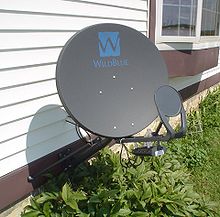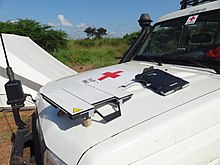Internet access via satellite
Internet via satellite is satellite broadband Internet access . Geostationary satellites are often used for this . However, there are also satellite constellations in low and medium earth orbit (LEO and MEO) that can be used for Internet access, for example O3b . With OneWeb and Starlink , two new large constellations of several hundred and thousand satellites respectively have been under construction since 2019.
variants
Basically, a distinction must be made between two types of satellite connection.
2-way satellite connection
With this form of connection, the outward and return channels (downstream and upstream) are established via a satellite (since 2013).
In the downstream , transmission rates between 64 kbit / s and 150 Mbit / s are available, depending on the provider , and different transmission rates in individual cases to be negotiated. The transmission rate of the upstream is between 64 kbit / s and 20 Mbit / s depending on the target group (end users and professional users). Technically, however, much higher transmission rates are possible. The Belgian satellite technology company Newtec reported in mid-June 2012 that it was using a 72 MHz transponder on a Eutelsat satellite to achieve speeds of over 500 Mbit / s.
1-way satellite connection
An asymmetrical connection, first used more than 15 years ago, in which only the downstream was routed via a satellite, but the upstream was via terrestrial connections. This technical solution was still used by tens of thousands of users in Europe until around 2013. At the time, downstream transmission rates between 256 kbit / s and 36000 kbit / s were available to the user, depending on the provider. The reception of the satellite signals can also take place with a commercially available DVB-S card , provided that the modulation is supported and compatible software is available.
The data transmission rate of the return channel was based on the technology used. Modem connections were mostly used via POTS or ISDN connections, which provided upstream rates of up to 128 kbit / s . For mobile applications, GPRS , UMTS or GSM connections could also be used for the return channel.
For connections with a terrestrial return channel, this was used by some providers in parallel to the satellite link for data transmission in the downstream direction. If this return channel is busy, the other packets flow over the satellite transmission route, which is more expensive for the provider. Conversely, this means: If the terrestrial line is not fully utilized - e.g. B. due to a slow Internet server - all data arrive terrestrially. For providers who did not use this technology, the actual download was exclusively via satellite.
advantages
The advantage of satellite connections lies in the combination of the relatively large bandwidth and its wide availability, which is largely independent of location.
The advantage of the pure satellite connection is that it is available completely independently of terrestrial data or telephone lines and no fixed location is required. It is therefore also available for ships and aircraft. The user only has to be in the broadcast area of a suitable satellite or move within it.
Another advantage is that the existing internet connection can also be used for making calls ( VoIP ). This makes a conventional telephone connection superfluous.
disadvantage
Latency and Slow Start
The long distances alone and despite the speed of light of around 300,000 km / s result in z. B. with geostationary satellites from the earth station to the satellite and back to the service user signal transit times of at least 239 ms. In the case of bidirectional communication via the satellite, this route must be overcome twice for the outbound route of inquiries and the return route of a response. Together with other delay factors, latencies between 500 and 700 ms result, which is comparatively significantly worse than z. B. the typical latencies of 150–200 ms for modem dial-up. DSL latencies are of the order of 20 ms. Internet services that use the satellite for there and back are therefore not suitable for video telephony and games or other applications in which high latency times are associated with severe restrictions.
The Transmission Control Protocol (TCP) is not designed for these high latencies. The Round Trip Time (RTT) resulting from these runtimes means that a TCP connection does not increase the data transfer rate significantly after the so-called slow start and so only a few 10 kbit / s could be transferred under unfavorable conditions even with a high theoretical data transfer rate. This problem can be avoided by using the Performance Enhancement Proxy .
Transparency vs. Transfer rate
The requirements for the most effective possible use of the theoretically available data transmission rates and the greatest possible application transparency can usually not be met at the same time. The most effective data transfer rate utilization is offered by the client / server variant with the one-way service . It routes the connection in front of and behind the satellite connection via a proxy server (client and remote proxy). In order to remain application-transparent, a tunnel variant ( VPN / PPTP ) is usually offered for the one-way service .
Data rate limitation
Similar to the use of the Internet via mobile radio, most providers of satellite Internet access also have a fair use policy that can lead to the actually available data rate being throttled.
development
There will be more and more broadband satellite connections in the near future in order to be able to satisfy the increasing demand for data as an additional component in addition to the fiber optic network. While the fiber optic expansion requires a lot of time and high investments, Internet via satellite is largely independent of location and online in a very short time.
providers
| providers | Broadcast area | position | product | Connection type | Downstream (max) | Upstream (max) | Downstream (min) | Upstream (min) | Dual play | Triple play |
|---|---|---|---|---|---|---|---|---|---|---|
| Arabsat | 2-way | |||||||||
| atrexx | Asia, Africa, Europe, Middle East, USA | 2way2sat LinkStar | 2-way | 2,048 kbit / s | 1,024 kbit / s | 128 kbit / s | 64 kbit / s | |||
| Businesscom Networks Limited | Asia, Africa, Europe, Middle East, North America, South America | "IDirect" - VSAT | 2-way | 8,000 kbit / s | 1,000 kbit / s | 256 kbit / s | 64 kbit / s | No | No | |
| CETel GmbH | Europe | 2-way | ||||||||
| Comnet | India | 2-way | ||||||||
| dsl2u | Europe | (= Eusanet 2010) | 2-way | 3,600 kbit / s | No | Yes | ||||
| EgyptSat Telecom | Africa | 2-way | 18,000 kbit / s | 4,200 kbit / s | ||||||
| EUTELSAT SA | Europe | 9 ° East | tooway | 2-way | 30,000 kbit / s | 6,000 kbit / s | Yes | Yes | ||
| EUSA NET GmbH | Europe | SATSPEED / KA-SAT / VSAT | 2-way | 30,000 kbit / s | 6,000 kbit / s | Yes | Yes | |||
| Filiago | Europe |
SES Broadband AVANTI Eutelsat |
2-way | 30,000 kbit / s | 6,000 kbit / s | 10,000 kbit / s | 256 kbit / s | Yes | Yes | |
| getinternet GmbH | Europe | Tooway – KA SAT | 2-way | 22,000 kbit / s | 64 kbit / s | 64 kbit / s | 1,000 kbit / s | No | No | |
| Global star | Sat-Fi | 2-way | ||||||||
| HughesNet | Alaska, Canada, Puerto Rico, USA | 2-way | 15,000 kbit / s | |||||||
| Inmarsat | Broadband Global Area Network | 2-way | 700 kbit / s | |||||||
| IPcopter | Europe | fnp012 | 2-way | 10,000 kbit / s | 256 kbit / s | |||||
| IPSTAR | Asia, Australia | Ultimate "Vol" | 2-way | 4,000 kbit / s | 2,000 kbit / s | |||||
| iridium | Worldwide | Iridium (-NEXT) | 2-way | 128 kbit / s (1,400 kbit / s) | 128 kbit / s | 2.4 kbit / s | 2.4 kbit / s | Yes | No | |
| level421 | Africa, Europe | 2-way | ||||||||
| Novostream GmbH | Europe | 28.2 ° East / 31.0 ° East | Astra-KA SAT / Avanti | 2-way | 20,000 - 50,000 kbit / s | 2,000 - 4,000 kbit / s | no throttling | no throttling | No | No |
| ORBITCOM GmbH | Europe | Astra – KA SAT | 2-way | 20,000 kbit / s | 2,000 kbit / s | 256 kbit / s | 256 kbit / s | No | No | |
| SAT network | Europe | 2-way | 10,000 kbit / s | 4,000 kbit / s | Yes | Yes | ||||
| Sat Internet Services GmbH | Europe | Tooway – VSAT | 2-way | 22,000 kbit / s | 6,000 kbit / s | k. A. | k. A. | Yes | Yes | |
| Bugle | Europe | 2-way | ||||||||
| SES Astra | Europe | 28.2 ° East | Astra Connect | 2-way | 25,000 kbit / s | 2,000 kbit / s | ||||
| SkyGate | Europe, Middle East | "Volume" | 2-way | 4,096 kbit / s | 256 kbit / s | Yes | Yes | |||
| skyDSL | Europe | skyDSL2 + / KA-SAT / VSAT | 2-way | 25,000 kbit / s | 6,000 kbit / s | 6,000 kbit / s | 1,000 kbit / s | Yes | Yes | |
| Sosat | Europe | dsDSL power | 2-way | 22,528 kbit / s | 6,144 kbit / s | 256 | 64 | |||
| Spacenet | North America | 2-way | ||||||||
| StarDSL | Europe | Tooway | 2-way | 22,000 kbit / s | 6,000 kbit / s | |||||
| Thuraya | Europe, Africa, Asia, Australia | ThurayaIP | 2-way | 444 kbit / s | 444 kbit / s | 16 kbit / s | 16 kbit / s | No | No | |
| Vconn / AZ Communication | Philippines | VCONN VSAT | 2-way | 1,000 kbit / s | 512 kbit / s | |||||
| WildBlue | North America | Liberty "GB" | 2-way | 25,000 kbit / s | 3,000 kbit / s |
See also
- DVB-S , DVB-RCS
- Project Loon
Web links
Individual evidence
- ↑ Filiago brings Internet via satellite with a return channel , golem.de
- ↑ And again the broadband desert got a lot smaller. Filiago GmbH & Co KG, August 3, 2012, accessed on January 31, 2015 .
- ↑ Internet in the countryside from Novostream | High speed internet | No DSL? Accessed November 15, 2018 (German).
- ↑ ASTRA Connect | Astra. Retrieved November 15, 2018 .
- ↑ StarDSL is now offering Internet via satellite with a return channel , golem.de
- ↑ thuraya.com Thuraya IP Price Plans


